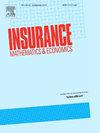通过风险预算进行投资组合选择和风险分担
IF 2.2
2区 经济学
Q2 ECONOMICS
引用次数: 0
摘要
风险预算是一种有效的风险管理工具,决策者使用它来创建具有预先确定的风险概况的风险组合。本文对如何在不同环境下构建风险预算组合进行了丰富的理论和实践讨论。我们重新审视了通常的投资组合选择设置,有或没有聚集风险预算目标,然后我们提供了一种方法,说明如何将通常的设置扩展到存在不可对冲风险或决策者针对固定子投资组合的情况。本文的另一个研究是如何将风险预算目标纳入风险分担,这在文献中还没有讨论过。还讨论了实现问题,并提供了一些定制算法来识别此类风险预算组合。对真实的金融数据进行了数值实验,并解释了我们提出的投资组合的风险缓解效果。具体而言,构建了以社会责任为目标的财务风险预算组合。本文章由计算机程序翻译,如有差异,请以英文原文为准。
Portfolio selection and risk sharing via risk budgeting
Risk budgeting is an effective risk management tool that a decision-maker uses to create a risk portfolio with a pre-determined risk profile. This paper provides a rich discussion about the theory and practice on how to construct risk budgeting portfolios in a variety of settings. We revisit the usual portfolio selection setting with and without clustered risk budgeting targets, and we then provide an approach on how to extend the usual setting to situations in which a non-hedgeable risk is present or fixed sub-portfolios are aimed by the decision-maker. Another study of this paper is how to include risk budgeting targets in risk sharing, which has not been discussed in the literature. Implementation issues are also discussed, and some bespoke algorithms are provided to identify such risk budgeting portfolios. Numerical experiments are performed for real-life financial data, and we explain the risk mitigation effect of our proposed portfolio. Specifically, financial risk budgeting portfolios with social responsibility targets are constructed.
求助全文
通过发布文献求助,成功后即可免费获取论文全文。
去求助
来源期刊

Insurance Mathematics & Economics
管理科学-数学跨学科应用
CiteScore
3.40
自引率
15.80%
发文量
90
审稿时长
17.3 weeks
期刊介绍:
Insurance: Mathematics and Economics publishes leading research spanning all fields of actuarial science research. It appears six times per year and is the largest journal in actuarial science research around the world.
Insurance: Mathematics and Economics is an international academic journal that aims to strengthen the communication between individuals and groups who develop and apply research results in actuarial science. The journal feels a particular obligation to facilitate closer cooperation between those who conduct research in insurance mathematics and quantitative insurance economics, and practicing actuaries who are interested in the implementation of the results. To this purpose, Insurance: Mathematics and Economics publishes high-quality articles of broad international interest, concerned with either the theory of insurance mathematics and quantitative insurance economics or the inventive application of it, including empirical or experimental results. Articles that combine several of these aspects are particularly considered.
 求助内容:
求助内容: 应助结果提醒方式:
应助结果提醒方式:


